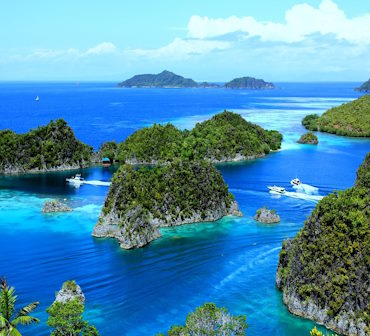
The Raja Ampat islands are a truly natural phenomenon with enormous biological diversity.
Located off the northwest tip of Bird’s Head Peninsula on the island of New Guinea, in Indonesia’s West Papua province, Raja Ampat, or the Four Kings, is an archipelago comprising over 1,500 small islands, cays, and shoals surrounding the four main islands of Misool, Salawati, Batanta, and Waigeo, and the smaller island of Kofiau.
Amazing marine biodiversity and untouched landscapes combined with world class scuba diving make these largely uninhabited islands the world’s last diving frontier.
According to Conservation International, marine surveys suggest that the marine life diversity in the Raja Ampat area is the highest recorded on Earth. Diversity is considerably greater than any other area sampled in the Coral Triangle composed of Indonesia, Malaysia, Philippines, Papua New Guinea, Solomon Islands, and Timor-Leste. The Coral Triangle is the heart of the world’s coral reef biodiversity, making Raja Ampat quite possibly the richest coral reef ecosystems in the world.
The area’s massive coral colonies along with relatively high sea surface temperatures, also suggest that its reefs may be relatively resistant to threats like coral bleaching and coral disease, which now jeopardize the survival of other coral ecosystems around the world. The Raja Ampat islands are remote and relatively undisturbed by humans.
The high marine diversity in Raja Ampat is strongly influenced by its position between the Indian and Pacific Oceans, as coral and fish larvae are more easily shared between the two oceans. Raja Ampat’s coral diversity, resilience, and role as a source for larval dispersal make it a global priority for marine protection.
1,309 fish species, 537 coral species (a remarkable 96% of all scleractinia recorded from Indonesia are likely to occur in these islands and 75% of all species that exist in the world), and 699 mollusk species, the variety of marine life is staggering. Some areas boast enormous schools of fish and regular sightings of sharks, such as wobbegongs.
And while the coral reefs and marine life are incredible, the scenery above the surface is also breathtaking. The rocky islands in the clear blue water of Piaynem offer some of the most spectacular sights in the world, and the view of the incredible formation of rocky islets are amazing and can be seen from Wayag Island. Amid the many dense jungles within the island, a variety of bird species can be found, including the spectacular bird of paradise. An endemic marsupial species called the spotted Waigeou cuscus also lives on land.
In East Waigeo, particularly in front of Urbinasopen and Yesner villages, there is a very interesting and unique natural phenomenon, which can only be seen every year-end.
A light comes out from the ocean and wanders around on its surface for about 10 – 18 minutes. After that, it disappears and can only be seen again at the following years-end.
Local inhabitants in both villages call this phenomenon the “Sea Ghost”.
The authorities and environmental activists actively involved the local population in the protection. They educated them and turned them into real nature protectors. The fascinating story of how this archipelago turned from an oasis for illegal hunting of sharks for their fins into an ecological and natural paradise is presented in the documentary Tales by Light by Shawn Heinrichs.


